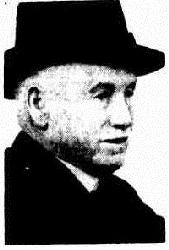James H.F. Eastman 1861 - 1934
On 15 June 1934, at the age of seventy-three, press photographer James H. F. Eastman died on the job, focussing his camera in preparation for taking a photograph at the Holden Motor Body factory in Melbourne. It was a remarkable way to put a close on forty years of work for a number of Melbourne newspapers, including the Argus, the Star and the Australasian. He was the oldest newspaper photographer in Melbourne and he claimed himself to be ‘the father of Australian press photographers’.
Born on February 9, 1861, in Richmond, Victoria, Eastman was educated at St. Stephen's Church of England Grammar School, Richmond. In 1873, he entered the service of Mr. F. A. Dunne at Lafayette Studio and, following the sale of the business to Foster and Martin, he remained with the new firm until he joined the staff of the Australasian in June, 1895.
Eastman photographed every Melbourne Cup since ‘before the days of Carbine’ and was the first to take an instantaneous photograph of the Melbourne Cup, when in 1886 he snapped Arsenal crossing the finish line for the Australasian Sketcher. He was an official photographer on four royal tours of Australia and throughout the eastern states he was ‘recognised by owners and breeders of stock as having no peer as a photographer of animals’. Working throughout Victoria and New South Wales, and occasionally venturing into Queensland, he was the ‘personal friend of hundreds of farmers’.
His anecdotes were often featured in a column called ‘News behind the news’ and his experiences could have filled volumes of edited collections. Anecdotes relating to his coverage of royal tours, including by the Duke of Edinburgh, the Duke of York, the Prince of Wales, and the Duke and Duchess of York were amongst his favourites. The most prized of the mementoes presented to him by distinguished visitors was an autographed photograph of the Prince of Wales.
According to those who knew him, ‘Jimmy’ Eastman, ‘knew only one set of orders, those of his editor in chief.’ During the visit of the Duke of York to Australia for the opening of the first Federal Parliament in 1901, Eastman was assigned to the tour for the Argus, and the Australasian. Journalists and photographers had been forbidden to join a shooting party at Kilmany Park, near Sale, where the Duke had been taken for a short rest. Under instructions from his editor, Eastman went secretly to Sale and met the royal train at the station. An official excitedly warned him off, but eventually Eastman pleaded his case with the Lieutenant Governor, Sir John Madden, who called to the detective in charge, asking, ‘How many men have you in this party?’ ‘Five,’ was the reply. ‘Well,’ said Sir John Madden, ‘six will not make any difference.’ And so Eastman joined the party.
Eastman was quietly preparing to photograph the Duke as he was about to take a shot. The Duke heard a rustle, lowered the gun, turned toward the photographer and said, ‘Good morning. How is the light for photography?’ ‘Excellent, Your Royal Highness,’ replied Eastman. The Duke again took aim and the click of the camera shutter followed the report of the gun. A photograph taken by Mr. Eastman of the Duke, laughing heartily at the antics of a koala in a tree, was said to be the only photograph ever taken of the man who would become King with such a ‘laughing countenance.’
Eastman became used to creating controversy. According to one report, after he had photographed the laying of the foundation stone of St. Paul's Cathedral in Melbourne, he caused a sensation at the consecration of the building. ‘Although warned that no photographs were to be taken, he hid behind a pillar in the aisle, aligned his camera, and set off a blast of magnesium. Lay canons and police crowded around, demanding the surrender of the plate, but Mr. Eastman slipped it into the hands of his assistant.’ On another occasion, Eastman found himself arrested, placed under armed guard and marched through Queenscliff. He was treated as a spy during a successful attempt to obtain a photograph from an unusual angle of the wreck of the P. and O. mail liner Australia, which struck near Port Philip Heads. He had climbed into the forbidden area of the Queenscliff fort to take the shot and refused to give up his plates.
Eastman also managed to find himself in dangerous situations from time to time. ‘A bombardment of earth spoiled a picture when, in 1897, a blasting operation connected with a ceremony at the time of the widening of the Yarra River proved exceptionally violent. Eastman and his camera were within the “range of fire”, but they escaped with a soiling.’ And once, after climbing out of the wreckage of a train smash when returning from an agricultural show near Melbourne, Eastman, with a broken rib, covered the story, returned to the office and did his own developing.
Eastman was a foundation member of the Australian Journalists' Association. In his younger years he took a keen interest in Victorian football and became the second secretary of the Richmond Football Club. He played with the Richmond Cricket Club. At his death, Eastman left a widow, three sons – two of whom went on to work in newspapers - and two daughters. At the time of his death three generations of the family were employed on the staff of the Argus,. Mr. Eastman was a member of the United Press Lodge, and of the Malvern branch of the Australian Natives' Association. He was buried at the St Kilda cemetery.
Sources
- ‘Noted Press Photographer, Mr J.H.F. Eastman, Dies’, Argus, 16 June 1934, p. 20. http://trove.nla.gov.au/ndp/del/article/10947075
- J.H.F Eastman, ‘Memories of My Camera: Trials of a Press Photographer’, Argus, 31 May 1930, p. 3S http://trove.nla.gov.au/ndp/del/article/4090722>
